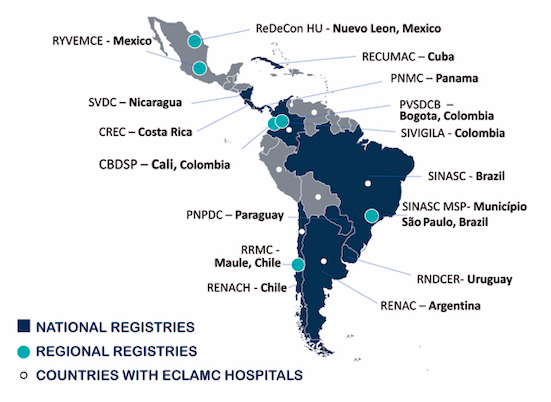October 22, 2019
Zika surged onto the world stage in 2015 in Brazil and within the next two years, hundreds of thousands of people had been infected and more than 3,500 babies were estimated to have experienced Zika-related birth defects in Latin America. By 2016, WHO had declared a public health emergency. Now, four years later, the epidemic has waned but still serves as a stark reminder of the critical role birth defects surveillance plays in the prevention and containment of disease.
In response to the need for better surveillance that the Zika epidemic highlighted, in 2016 epidemiologists and doctors from Brazil, Cuba, the USA, and the UK took action. Those initial collaborators included: Professor Ieda Orioli and Dr Eduardo Enrique Castilla from ECLAMC in Brazil; Drs Rosa Liascovich, Boris Groisman, Pablo Barbero, and Maria Paz Bidondo, in Argentina; Dr Dácio Rabello in Brazil; Drs Aurora Canessa, Rosa Andrea Pardo, and Cecilia Mellado in Chile; Dr Beatriz Suárez in Cuba; Drs Ignacio Zarante and Paula Hurtado in Colombia; Professor Helen Dolk former Director of EUROCAT in Northern Ireland; and, Diana Valencia from US CDC in the USA. They began to organize a new surveillance network that would span the whole of Latin America, from Mexico and the Caribbean in the north all the way to Argentina in the south. This emerging network is called Rede Latino Americana de Malformações Congênitas (Latin American Congenital Malformations Network), or ReLAMC for short.
Over the next two years, the effort grew as doctors from Mexico, Panama, Nicaragua, Costa Rica, Colombia, Brazil, Paraguay, and Uruguay joined forces in this emerging network. ReLAMC members and interested researchers and stakeholders will be meeting in Porto Alegre, Brazil from November 3-8, 2019, to invigorate and advance their newly formed Latin American network of congenital anomaly registries.
ReLAMC builds on the foundation that another surveillance network, ECLAMC, established over the last 50 years. And, in fact, the meeting this November will be held alongside an ECLAMC meeting where the interested stakeholders are leveraging what already exists with ECLAMC and advancing those efforts through ReLAMC for better data collection for birth defects surveillance throughout Latin America.
ECLAMC (Estudio Colaborativo Latino Americano de Malformaciones Congénitas / Latin American Collaborative Study of Congenital Malformations) is an active hospital network of birth defects registries throughout South America. For more information on ECLAMC, read our article here. ReLAMC integrates ECLAMC but expands the network of registries to include not only hospitals but also national and regional registry systems, thus enhancing the research potential for the entire continent.
At present, ten national registries and six regional registries (functioning in four countries) operate in Latin America. See the map below for the registries invited to participate in ReLAMC. Ten registries formalised their participation in ReLAMC and a pilot test of data sharing took place; participation is actively growing as national governments approve new participants. The exchange of data will be carried out through an electronic portal.
The goal of ReLAMC is to provide public, online, current and reliable reference frequencies of congenital anomalies from each participating registry. In so doing, the data can support collaborative research on the causes and prevention of congenital anomalies, as well as aid public health decision making.

For more information on surveillance networks, see our comprehensive resource inventory. Do you have feedback or resources to share? Contact us. We always love hearing from our visitors.
For more information on ZikaPLAN, the EUH2020 project that has partially supported the formation of ReLAMC, click here.

ECLAMC members. For info on the next meeting eclamc.org/rae or email relamcoord@gmail.com